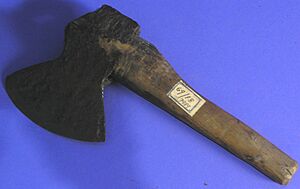Hafting facts for kids
Hafting is a cool way to attach a tool, like a stone blade or a metal head, to a handle or stick. Think of it as giving a sharp stone a sturdy grip! This makes the tool much more useful. For example, a stone can become a powerful axe or a sharp spear.
When a tool is hafted well, it can be thrown further or used with more power. This made hunting and daily tasks much easier for early humans. Experts believe that hafted tools were very common during the Upper Paleolithic and Middle Paleolithic periods, which were ancient times. Hafting was a huge step forward because it showed that early humans could combine different parts to create a single, more advanced tool. It proved they were thinking in new, complex ways!
Even though hafting was super important in prehistory, people still practice these old methods today. The handle of a tool like an axe is still called a "haft." Many people enjoy learning how to attach handles using traditional ways. They try to find the best methods to make tools strong and work well. The basic idea of hafting is still seen in modern tools like hammers and axes. Over time, the ways people hafted tools have changed and improved a lot.
Contents
How Tools Get Handles
To haft a tool, you need two main parts: the tool itself (like a stone blade) and the handle (often a piece of wood).
Preparing the Tool
First, the tool needs a special shape to connect to the handle. Often, people would create small grooves or "flanges" on the tool. These are like little notches carved into the stone. They were made by carefully chipping away extra stone. These grooves help the tool stay firmly attached to the handle.
Getting the Handle Ready
Next, the handle, usually made of wood, needs to be prepared. A good handle is strong enough but also comfortable to hold. Sometimes, the outer bark was removed to make it smoother and prevent splinters.
Attaching the tool to the handle can be tricky! People used different methods to make the wood softer. They might burn the end of the wood or soak it in water. This made it easier to cut a slit or split the wood down the middle. The tool's head would then fit perfectly into this opening. If the wood was split, the tool could sit deep inside the handle, making it even stronger once wrapped up.
Attaching the Parts
Once the tool is in place, it needs to be held tightly. People would tie strong materials around the tool and the handle, especially around those special grooves. Materials like tough plant fibers or even animal intestines were used because they were very strong. Sometimes, they would wrap the material around the handle too, to give a better grip.
One challenge with tying is that the fibers can loosen over time, especially if it's humid. To make the connection even stronger, people sometimes added glue. When glue or a sticky resin is used, it's called "mastic hafting." These tools were super strong because the glue stopped any movement. Glue also helped absorb shock when the tool was used, like when chopping wood.
Before modern glues, people made their own from natural materials. These ancient glues were often a mix of things like animal waste, tree bark, and charcoal. The main downside of using glue was that it took a lot of time and effort to make and use.
It usually took much longer to create the hafting (the binding part) than to make the tool itself. For example, making a stone spear point might take about twenty minutes, but attaching it securely could take several hours! Often, a tool would be replaced or sharpened many times during the life of the haft. This kept the hafted tool working its best.
Hafting in Ancient Times
Hafting was a game-changer for early humans. More than 125,000 years ago, early humans like Homo heidelbergensis started using hafted stone tools a lot. Over time, hafting methods got better, and tools became more effective. Early hafts might have had small handles and dull stone tools. But later, they had longer, stronger handles with sharper, narrower tools perfect for piercing and cutting.
Hafting stone points, especially for spears, was a huge step forward. These hafted spear points made hunting much more efficient. They allowed early people to hunt and kill animals more easily. This increased access to meat and other good foods. Some scientists believe that eating more meat around this time might even be linked to the growth in brain size seen in ancient human remains.
Scientists have found evidence that stone points from a site in South Africa, dating back about 500,000 years, were used as spear tips. This suggests that the common ancestors of modern humans and Neanderthals started hafting tools almost half a million years ago!


